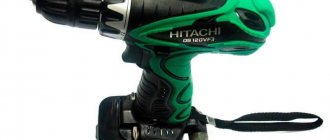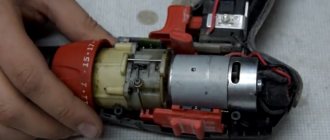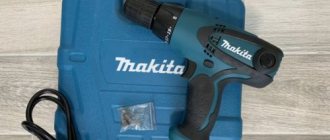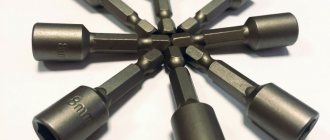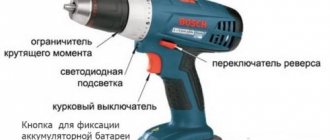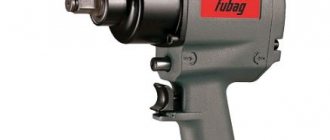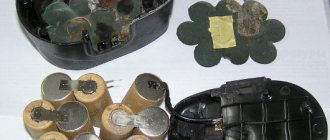A screwdriver is a very useful tool in everyday life, even for a woman. Shelves, mechanisms, everything is fixed with fasteners: bolts, screws or self-tapping screws. It’s one thing when there are only a few of them – a screwdriver is enough. However, if you need to assemble furniture, make repairs, or move to a new apartment, then you cannot do without a reliable brushed or brushless screwdriver.
Differences between a brushless and brushed screwdriver
The design of a brushless screwdriver does not have a commutator unit with brushes, which is why these models are also called brushless. This unit consists of brushes that rub against the rotor and supply electricity to it. With their help, the windings are switched, creating a magnetic field that drives the motor rotor. The functions of the collector in a brushless tool are performed by an electronic unit in which switching occurs with the help of transistors and other elements.
By replacing the collector with an electronic board, manufacturers were able to eliminate some of the weaknesses of electric motors and increase efficiency. In this regard, it can be argued that brushless screwdrivers are superior to their brushed counterparts in almost all respects. However, there remain nuances that allow the latter the right to exist.
Device, pros and cons
Electric screwdrivers differ from each other in their power supply principle: there are mains ones with a power supply of 220 volts and portable ones equipped with a battery. In addition, models can be equipped with a striking mechanism. No other fundamental innovations have been introduced over the last decade, with the exception of one – a brushless mechanism.
Brush screwdriver
The most common type - a commutator motor - is installed on most models. Its operating principle is simple: the windings are switched mechanically and in the armature chain. The contacts are a collector, and energy is transferred thanks to spring-loaded brushes.
Strengths:
- old, reliable technology;
- low cost of parts;
- simplicity and clarity of repair.
Flaws:
- collector lead to energy losses, which means lower efficiency;
- occurrence of sparks, heating of the motor;
- interdependence of speed and torque;
- power losses during reverse operation;
- rapid wear;
- loss of speed under load.
The brush motor has many weaknesses, but they can be justified by cheap components and ease of repair - this is a more affordable option.
Brushless screwdriver
With inverter models the situation is the opposite. They are more efficient and more suitable for the job. Advantages:
- the ability to control the rotation speed: the user receives a wide range of settings - the rotation can be adjusted, depending on the nature of the work and the surface being processed.
- the engine does not provide a commutator-brush assembly, which means that the tool will break less often (if it is used correctly), and maintenance will not cause problems due to the simplicity of the design;
- models cope more effectively with increased load caused by high torque;
- battery power, if it is a portable screwdriver, is consumed more economically;
- higher efficiency - brushless motor produces 90%;
- the ability to operate the tool in a hazardous environment: near gas mixtures and flammable substances (the inverter motor operates without a spark);
- the same power is maintained in forward and reverse mode;
- increased load does not lead to a decrease in rotation speed.
Weak sides:
- high price;
- the large size of the body, when compared with brush models, makes it difficult to work at arm's length or penetrate into tight spaces.
When choosing, it is important to pay attention to the type of battery inside the screwdriver. If you think correctly, then the tool will serve the owner faithfully for many years without loss of performance.
Dimensions
The commutator unit is up to half the length of the rotor, therefore, a motor without brushes will be much smaller, while maintaining its power. At the same time, the difference in the weight of screwdrivers can reach several hundred grams. This feature will be appreciated by those who work with professional tools, when they have to screw in hundreds of screws every day. But for domestic needs this parameter may not be critical.
Also find out how to remove a screwdriver cartridge: https://myinstrumenty.ru/elektroinstrument/kak-snyat-patron-s-shurupoverta/
Brushed vs Brushless: Summary Table
Now - a comparative description of the two types of tools in the form of a table with key parameters.
| Characteristics | Screwdriver type | |
| Brush | Brushless | |
| Efficiency | up to 60% | 90% |
| Wear | faster | longer |
| Battery life | less | almost 2 times longer |
| Price | below | higher |
| Dimensions | more | less |
| Weight | heavier | easier |
| Overheat | There is | No |
| Noisy operation | loud | quiet |
| Repair | easily | extremely problematic |
| Application area | house | no limits |
| Work in fire hazardous areas | big risk | safely |
Noticeable difference in body size
Resource
Brushes are, in fact, consumables, because during use they can wear out or burn out. Changing them is not difficult, especially since it is rarely necessary to do this. However, a brushless tool is completely devoid of this. Since there are no rubbing units in this tool, nothing will be erased. It turns out that a brushless screwdriver is not only safer, but also lasts longer.
Advantages of brushless motors in theory
We have already figured out the structure of a brushless motor and now it is worth considering the positive and negative aspects of such tools.
There are several advantages of such engines:
- They do not have the problems that brushed models have. They are more resistant to wear, since the brushes do not produce internal friction. The fire rate is also lower. The absence of sparking allows you to work in the most difficult conditions.
- Easier torque control system. The number of levels (15) allows you to immediately select the desired mode and simply press a button. They have a higher level of efficiency.
- Economical in terms of energy use. This is especially true. If the engine is battery-powered. The tool can be used on any material.
Important! In addition, brushless motors can produce maximum rotation almost immediately.
Reliability
The design of the electric motor is quite simple, and if used in normal mode, it will last a very long time. the vulnerable point is the control unit, which is subject to the greatest wear. The collector unit is simple to implement and is not expensive, so you still need to try to disable it. But transistors can be damaged, for example, when working in an aggressive environment. At the same time, the rotor can “stick”, as a result of which there is a possibility that the winding will burn out. In this case, a good electronic unit will stop the supply of electricity, thereby protecting the tool. It is quite difficult to make an unambiguous conclusion which screwdriver is more reliable.
Dimensions
Commutator assembly Assembly Tool House
The trump card of brushless motors is the absence of a commutator assembly that takes up space. This unit constitutes up to 30–50% of the rotor length, which means that a motor without brushes can be just as compact with comparable power. This is especially true for professional tools, whose task is not just to screw three screws under a shelf or assemble a new cabinet, but to tighten hundreds of screws a day.
Reducing the motor affects the overall dimensions of the screwdriver. For example, the budget model BLACK+DECKER BCD001BA10S is 150 grams lighter than its “brother” BLACK+DECKER CD121, which has a more powerful engine, and is a little more compact. And when you need to work for several hours in a row, then every hundred grams matters.
Price
A brushless screwdriver wins in most respects:
- Weight;
- Size;
- Efficiency;
- Autonomy;
- Safety;
- Durability.
However, many household users are put off by its price. If a person rarely uses a tool, then a collector budget model of the tool will be enough for him.
If we talk about professional equipment, then without a doubt we can say that a brushless screwdriver is worth the money. By paying more, a person gets a more convenient and autonomous tool that performs its functions better.
A more detailed answer to the question which screwdriver is better, brushed or brushless, can be found at the link: https://myinstrumenty.ru/elektroinstrument/kakoy-shurupovert-luchshe-schetochnyy-ili-bezschetochnyy/
Efficiency
Replacing the brush assembly with an electronic unit made it possible to increase the engine efficiency by up to 1.5 times. In brushless models it reaches 90%, so energy is used much more efficiently. This is especially important for cordless tools, which is why brushless motors are more common in cordless tools.
Increasing energy efficiency by 1.5 times allows for a corresponding increase in autonomy. That is, if a regular brushed tool can tighten 200 screws on one charge, then a brushless tool with the same power and battery capacity will tighten all 300.
Purpose and properties of brushes for power tools
Brushes on any brand of screwdriver, including Bosch (Bosch PRS 1200, PRS 1440, PRS 1800, Bosch GSR 14.4 V li), Hitachi (Hitachi DS 12 DVF 3), Makita (Makita 6271 D, Makita DDF 454), Metabo, PIT and others, serve as a conductor of current . They participate in transmitting current to the rotor, thereby ensuring rotation. Therefore, the material for their manufacture must conduct electricity and be hard so that it does not wear out much under the influence of friction.
Carbon (graphite) brushes meet these requirements . This material is not welded to the metal in the event of an electric arc occurring between the contacts. And it occurs very often during engine operation. The brushes on the screwdriver must be resistant to temperature, mechanical and chemical influences, and have high thermal conductivity. Good brushes have a long service life and spark little.
You need to choose these parts carefully, because they are available in different sizes . To replace, you need to take products for a specific screwdriver model and the same manufacturer. It must be borne in mind that under heavy loads and intensive use of the tool, the brushes will not last long.
Carbon brushes for screwdriver
The benefits of brushless tools in practice
Theoretical advantages are fully realized in practice. This must be taken into account when choosing a brushed or brushless screwdriver; you can find out which motor is better after working with it.
Experts note that such a tool:
- Much lighter and smaller in size. Compactness makes it possible to work in difficult places and carry even in a regular bag.
- More powerful and efficient in energy consumption. The modern operating principle of the motor, based on the use of electronics, improves user performance.
- Brushless cordless models work on a single charge for quite a long time. Compared to classic engines, this is 30% more.
- Due to the low heat generation, no additional cooling or interruptions during operation are required.
- When working, it does not make too loud sounds or give sudden jerks.
- No sparks. This allows you to work in difficult conditions near fuel tanks and gas appliances.
- Easy to maintain. No need to buy or select brushes.
- It breaks less often, since the absence of a brush allows you to work even under high loads without fear of clogging the engine.
About labor costs
Repairing a screwdriver with a serviceable motor can be done relatively quickly. The same cannot be said about restoring a device that cannot be repaired. Think, maybe in the time required for repairs, you can earn enough money from what you know how to do, enough to buy a new one. After all, it’s not worth learning something to do it just once.
A screwdriver is a tool often used in the professional field during repair and construction work, as well as at home. Like any electromechanical device, screwdrivers are subject to malfunctions. This device is not a complex device, and if problems arise, you can repair the main faults of the screwdriver yourself.
Is it worth buying a tool with a brushless motor?
If you need a tool several times or just for home use, then it is better to choose a cheaper option. But professionals need a reliable and powerful screwdriver that will pay for itself very quickly. This can be understood by seeing how a brushless screwdriver works and how many processes can be done with it without interruption.
You can wait until the technology becomes more accessible. After all, it was introduced not so long ago and the new engines with which they are equipped are too expensive, unlike conventional ones. When analyzing the price, the difference will be 30-50%. Such overpayments are too significant to buy a tool just to have a home.
Operation of a brushless screwdriver
How to choose brushes correctly?
In a screwdriver, when the brushes wear out, they must be replaced. When choosing graphite brushes, consider the following parameters:
- shape;
- size;
- grade of graphite.
Also pay attention to the stiffness of the brushes and copper on the commutator. The degree of friction, which leads to wear of the brushes, depends on this parameter. In addition, the properties of the clamping block, the characteristics of the contact groups and the level of active resistance are important.
The reliability of the mechanism is also affected by the degree of brush pressure. Insufficient pressure leads to sparking in the engine, and too much pressure leads to overheating of the commutator and brush block.
Prices in online stores
Which screwdriver should you buy in 2020?
Rating of the best screwdrivers of 2022
| Category | Place | Name |
| Best 12V Screwdrivers | 1 | DeWALT DCD701D2 Li-Ion 2.0 Ah 12 V x2 case TSTAK 57.5 Nm |
| 2 | Makita DF333DWYE 30 Nm | |
| 3 | BOSCH GSR 120-LI 1.5Ah x2 Case | |
| The best 18V screwdrivers | 1 | BOSCH GSB 18-2-LI Plus 2.0Ah x2 Case 63 Nm |
Description of the device
A brushless screwdriver is a device equipped with brushless electric motors. Performs the following functions:
- Tightening and unscrewing screws and bolts.
- Thread cutting.
- Drilling materials of different thicknesses.
- Mixing mortars.
Important! Household products are characterized by average battery autonomy and low power. Used at home. Professional models do not require a charge for eight hours. They can be used to drill through metal or concrete structures.
Brushless screwdrivers include the following components:
- Frame. Made from durable plastic. The material has increased wear resistance to mechanical damage.
- DC motor.
- Control block. Regulates the rotation of the electric motor shaft.
- Gearbox.
Important! Cheap models are equipped with a gearbox, which includes plastic gears. They wear out quickly. Because of this, the equipment fails.
- Cartridge. Necessary for inserting attachments.
- Accumulator battery. It comes in both removable and built-in types.
Possible reasons
The main reason why sparks appear even on a new engine is the mechanical interaction of the commutator and brushes. Moving during operation of the tool from one commutator contact to another, the brushes alternately create and break contact with each of them.
To make it easier to understand the principle, remember the situation when you unplug an electrical appliance from a socket. When the circuit breaks, a spark occurs between the socket and the plug. So it is in this case. Minor sparking is completely normal.
But if sparks fly in a sheaf, this situation may be due to the following reasons:
- collector contacts in soot;
- graphite dust from the brushes got between the contacts;
- a short circuit has occurred in the armature winding.
Collector contamination
The mechanics of contamination of the commutator contacts are as follows: the electric motor overheats, carbon deposits settle on the commutator, which creates additional friction. As a result, the engine overheats again, even when operating at low speeds, the amount of carbon deposits increases, friction increases - and so on until the engine burns out altogether.
The solution to the problem is obvious and consists in cleaning the contacts. Do this using the finest (zero) sandpaper:
- Remove the manifold with the armature.
- Without applying excessive force, go over the contacts with sandpaper.
- Insert the module into place.
It is best to carry out cleaning using a lathe so as not to disturb the geometry of the part. But in practice, you can get by with manual work.
Dust in contacts
With regular use, even at low speeds, the screwdriver brushes wear out. As a result, graphite dust is formed. It accumulates on the motor contacts. And since graphite dust has its own resistance, an uneven distribution of current occurs, sparks appear, a characteristic smell - a complete feeling that the brushes of the screwdriver are burning.
If the brushes are installed correctly, their wear occurs very slowly and does not lead to such problems. Take your instrument apart and see what's going on there. Please note:
- the parts of the mechanism must fit tightly, without play;
- if a replacement was made, a brush of a not quite suitable size could be installed;
- Foreign objects, dust, or construction chips could get into the grooves.
Main screwdriver malfunctions and their causes
Below is a picture showing the internal structure of the battery device.
Screwdrivers can be equipped with both commutator electric motors and brushless motors (they do not have electric brushes).
If your screwdriver breaks down, then the malfunctions of this device may be the following.
- Device is not working. First of all, the electrical plug or cable may be faulty, the battery may be completely discharged or faulty. This problem can also be caused by burnt-out motor windings, a faulty start button, or worn brushes.
- When the device is operating, it sparks strongly. There may be a malfunction of the armature or motor commutator, as well as problems with the brushes.
- The battery discharges quickly. You will need to check the batteries included in the battery pack using a tester.
- The device turns on spontaneously. Most likely the start button is faulty.
- The engine brake does not work. In this case, it is necessary to replace the button or transistor, since these elements are responsible for braking.
- Chuck backlash. Most often, runout is caused by bending of the gear shaft.
- The ratchet doesn't work. Possible causes: worn ratchet locking blades, broken ratchet pins or springs.
- The cartridge rotates. A malfunction of the gearbox, namely its gears, can cause a situation where the cartridge slips. Also, the malfunction of this unit is the reason that the running motor does not turn the spindle.
- The chuck is jammed and it is impossible to unscrew and remove the drill or bit. As a rule, jamming of the clamping jaws occurs due to insufficient lubrication or breakage of the internal parts of the chuck.
All faults, except for the electrical plug, can only be eliminated after disassembling the device.
Self-replacement of brushes on a screwdriver
Choose a set of carbon brushes for a specific model. Before changing brushes, prepare a set of tools:
- round-tipped tongs;
- set of flat-head screwdrivers;
- a slotted screwdriver.
Replacing worn brushes
Some corded screwdrivers provide easy replacement of brushes. Here you just need to unscrew the compartment lid and take out the old brushes, which are replaced with new ones. But how can you replace the brushes on a screwdriver if there is no simplifying mechanism?
- Disassemble the screwdriver as indicated in the second paragraph of the engine cleaning instructions.
- Open the cover on the rear motor housing, then remove the brush holder.
- Check the dimensions of the old and new parts. If the new brushes are larger, sand the parts with sandpaper or a flat file.
- Compare the position of the contact wire terminals. If they do not fit, grooves are cut.
- Once the first 4 steps are completed, install the new brushes and connect the wires to the terminals. It is possible to solder old wires to new elements.
- After installing the brushes, check the operation of the tool. If the sound of the screwdriver is smooth and no spark appears in the engine, the device is functioning normally.
Electrical breakdowns
In the electrical circuit of a screwdriver, batteries often fail; the second place is shared by the buttons and the motor, in which the brushes most often deteriorate.
How to repair a battery yourself
To repair the battery, a preliminary check is required. To do this, the battery is charged and tested for power output for a certain time. If the released charge is small, then you can try to restore the nickel-cadmium batteries.
If the voltage is low and the current is too low, the battery must be repaired. Repair consists of finding faulty elements and replacing them. Lithium-ion battery packs require the use of charge balance controllers due to the series connection of the batteries, which can make repairs much more difficult and require the assistance of a qualified electronics technician. This is especially important because lithium-ion batteries can become a fire hazard if not properly repaired.
Replacing brushes
Replacing brushes is done quite often, especially for screwdrivers used by builders and installers who work with stone or near a source of stone dust. For example, it is enough to assemble a wooden rack with a screwdriver in a warehouse with cement so that the brushes are almost half worn out.
To replace the brushes, you need to disassemble the screwdriver, remove the motor and then remove the brushes. How exactly this is done depends on the engine design. Sometimes the brushes are fixed with plugs (this is the easiest case for replacing them), and sometimes they are pushed in the direction of the commutator axis. In some cases, it is necessary to resort to devices to temporarily hold the brushes during assembly.
Problems with the button
Buttons may break due to rough force. Splinters, small fragments of metal from self-tapping screws, or sheet metal that stick to the worker’s hands often get inside. This debris leads to jamming of the button, and if it is not removed in time, it easily bores the plastic case in which the button with the regulator is mounted.
As a result, the regulator begins to become unstable, the speed of the screwdriver jerks, and in the end it completely fails. The same applies to the reverse switch if it has an unfortunate design that does not protect it well from dust.
Repairing these parts is not always possible; this again depends on the specific design of the push-button assembly. Most often you have to replace the entire assembly with a new one. Electrical faults can be corrected by replacing parts.
How to disassemble a screwdriver for repairs
To disassemble the device, follow these steps:
- disconnect the battery pack from the device body;
- unscrew all the fasteners holding the 2 halves of the device together;
- remove the upper part of the housing;
- remove all contents from the device body;
- carefully disconnect the start button from the housing without damaging the wires connecting it to the engine;
- remove the speed switch;
- disconnect the motor, gearbox, coupling and cartridge by unscrewing the 4 screws;
To unscrew the cartridge, you will need to unscrew the screw, which can be seen inside the mechanism when the cams are unclenched. The screw should be unscrewed clockwise since it has a left-hand thread. After this, the cartridge must be unscrewed from the gearbox shaft by turning it to the left (right-hand thread).


